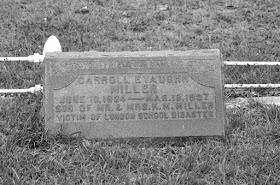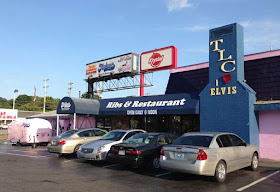 |
The New London school before the explosion
(historical photo)
|
On March 18th, at 3:17pm,the older students were in their last class, minutes away from the last bell. The children in kindergarten through 4th grade had already been dismissed for the day. The PTA was meeting in the gym as L. R. Butler, the instructor of manual training, turned on a sanding machine in the shop room under the building. Unfortunately, there had been a slow, but prolonged gas leak from a 2-inch pipe. At that time, no one had thought to add a noxious smell to gas to enable detection of it so even though it had accumulated in a large pocket, it had been undetected because it was colorless and odorless. When Mr. Butler turned on the switch, an electrical spark ignited the gas which had accumulated in an enclosed 253-foot long by 56-foot wide space beneath the basement floor.
 |
Minutes after the explosion
(historical photo)
|
Stunned parents at the PTA meeting ran to the school building and began frantically digging through the massive mound of ruble screaming for their children buried underneath. As word of the disaster quickly spread, the town’s residents came running with shovels and rakes. Roughnecks from the oilfields rushed to the school with heavy-duty equipment. Police, including members of the Highway Patrol and Texas Rangers arrived and pitched in to help.
It began to rain as darkness set in, but floodlights were
set up and the workers continued digging through the rubble looking for victims
all night. There were a few miracles as a survivor would be dug out of the
rubble, but mostly, the heart-breaking screams of anguished parents were heard
over and over as workers pulled another lifeless body of a child from the debris
and it was identified.
It took seventeen hours for all the victims to be recovered. Garages, churches and even the roller rink were all used as makeshift hospitals and morgues. Of the 500 students and 40 teachers, school employees and visitors in the building, 294 had died that day. Another 17 severely injured victims died in the days and weeks following the explosion bringing the total number to 311.
It took seventeen hours for all the victims to be recovered. Garages, churches and even the roller rink were all used as makeshift hospitals and morgues. Of the 500 students and 40 teachers, school employees and visitors in the building, 294 had died that day. Another 17 severely injured victims died in the days and weeks following the explosion bringing the total number to 311.
Killed in blast
|
Male
|
Female
|
Total
|
5th Grade
|
26
|
42
|
68
|
6th Grade
|
33
|
54
|
87
|
7th Grade
|
17
|
17
|
34
|
8th Grade
|
12
|
19
|
31
|
9th Grade
|
7
|
4
|
11
|
10th Grade
|
9
|
7
|
16
|
11th Grade
|
13
|
10
|
23
|
Teachers
|
3
|
13
|
16
|
Other
|
5
|
3
|
8
|
Totals
|
125
|
169
|
294
|
There were many horror stories. One family lost all three of
their children; one mother could positively identify her ten-year-old’s body
only because the little girl, while playing dress-up the night before, had used
a crayon to color her toenails red. A set of twins was found lying next to each
other, the boy’s arm in death reaching toward his sister. The youngest victim
was only 4 years-old. He had been excited to accompany his mother on a visit to
see his big sister’s class.
As the last of the debris was being removed from the site, a
blackboard was found beneath a large concrete block. The message the teacher
had written that day was still legible – “Oil and natural gas are East Texas’
greatest mineral blessings. Without them this school would not be here and none
of us would be here learning our lessons.”
Within two months, the Texas Legislature passed a law
requiring refiners to add a scent to odor-free natural gas. Today, because of
the familiar stink of a chemical called mercaptan, another tragedy like New London
will never happen again.




















